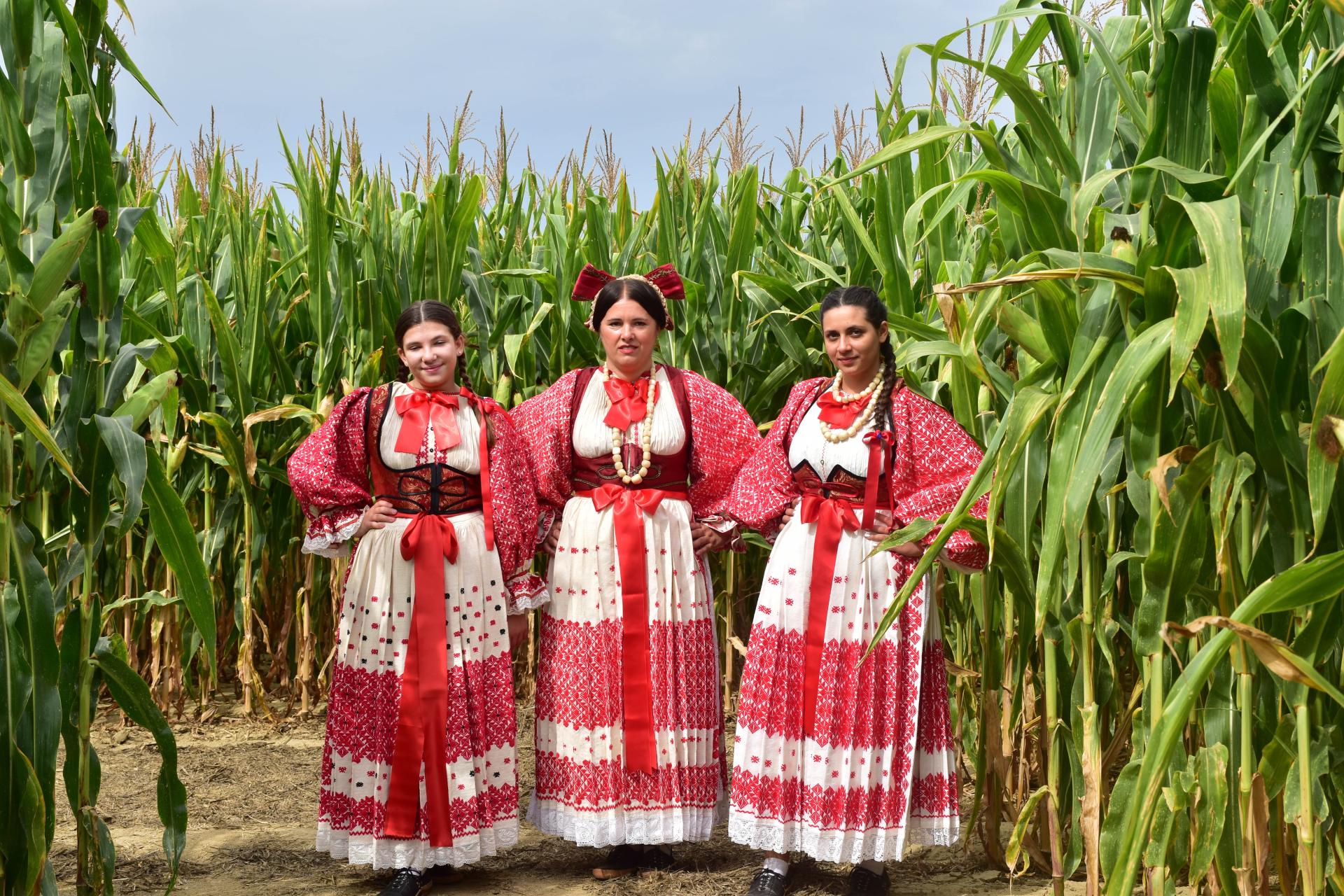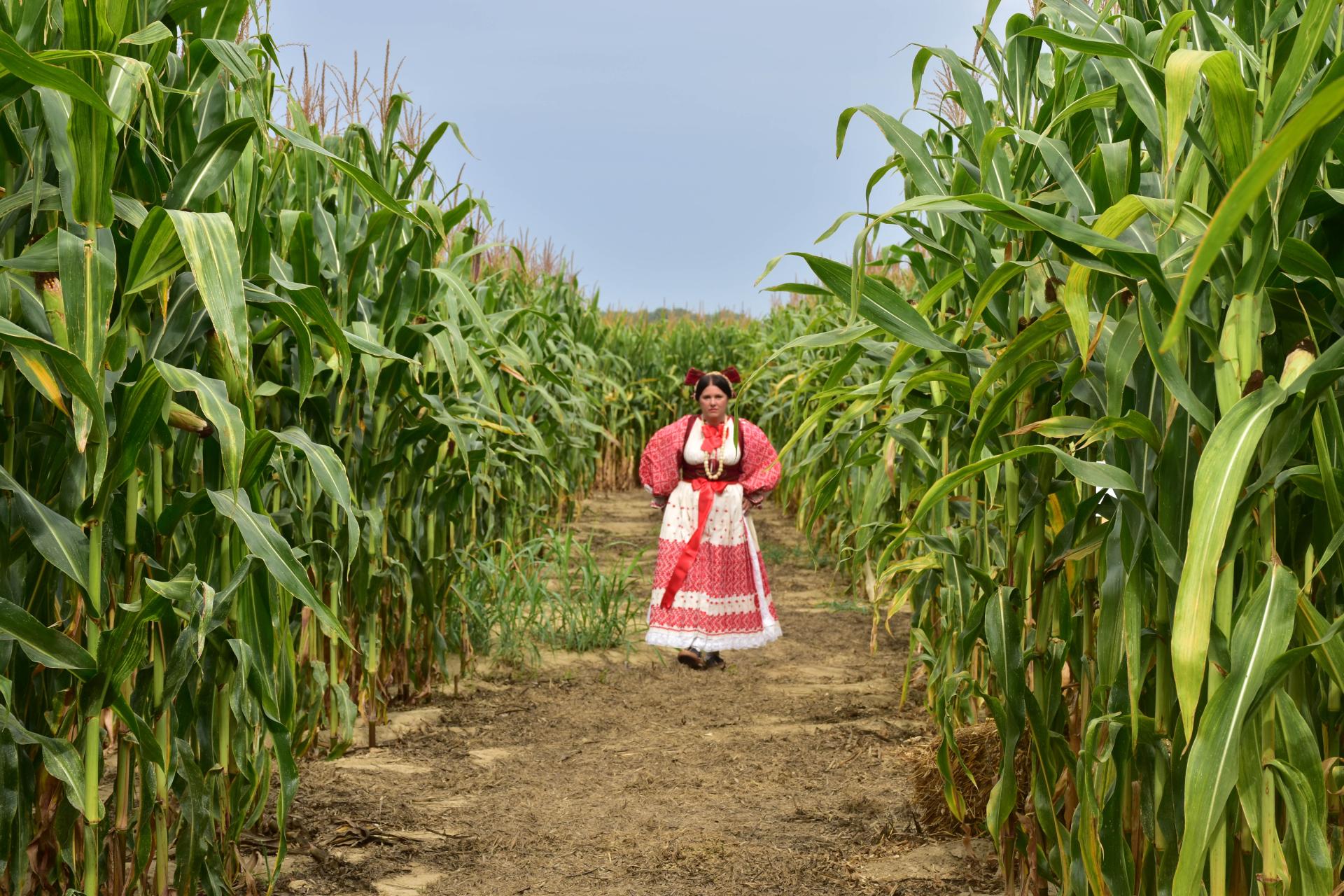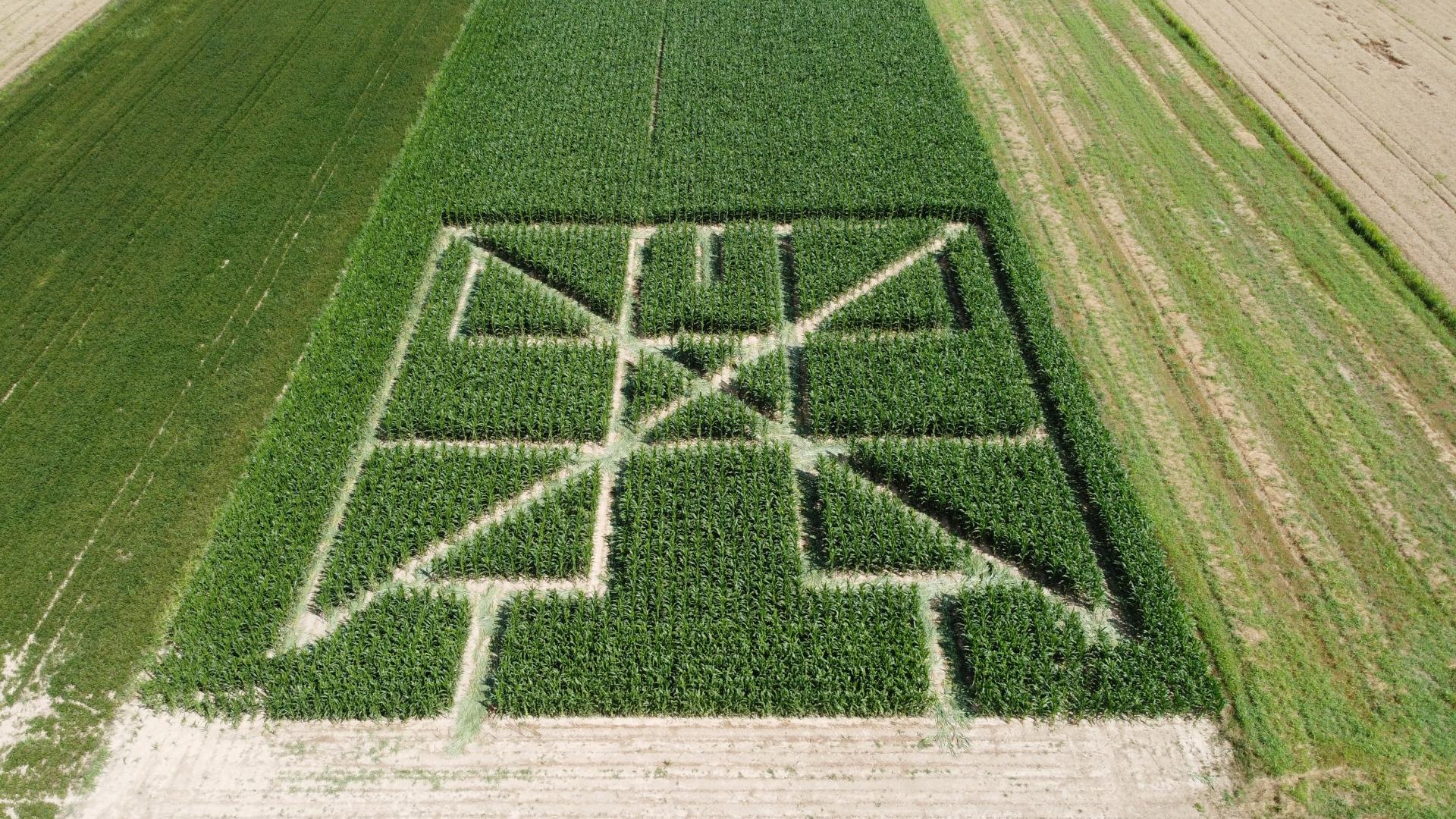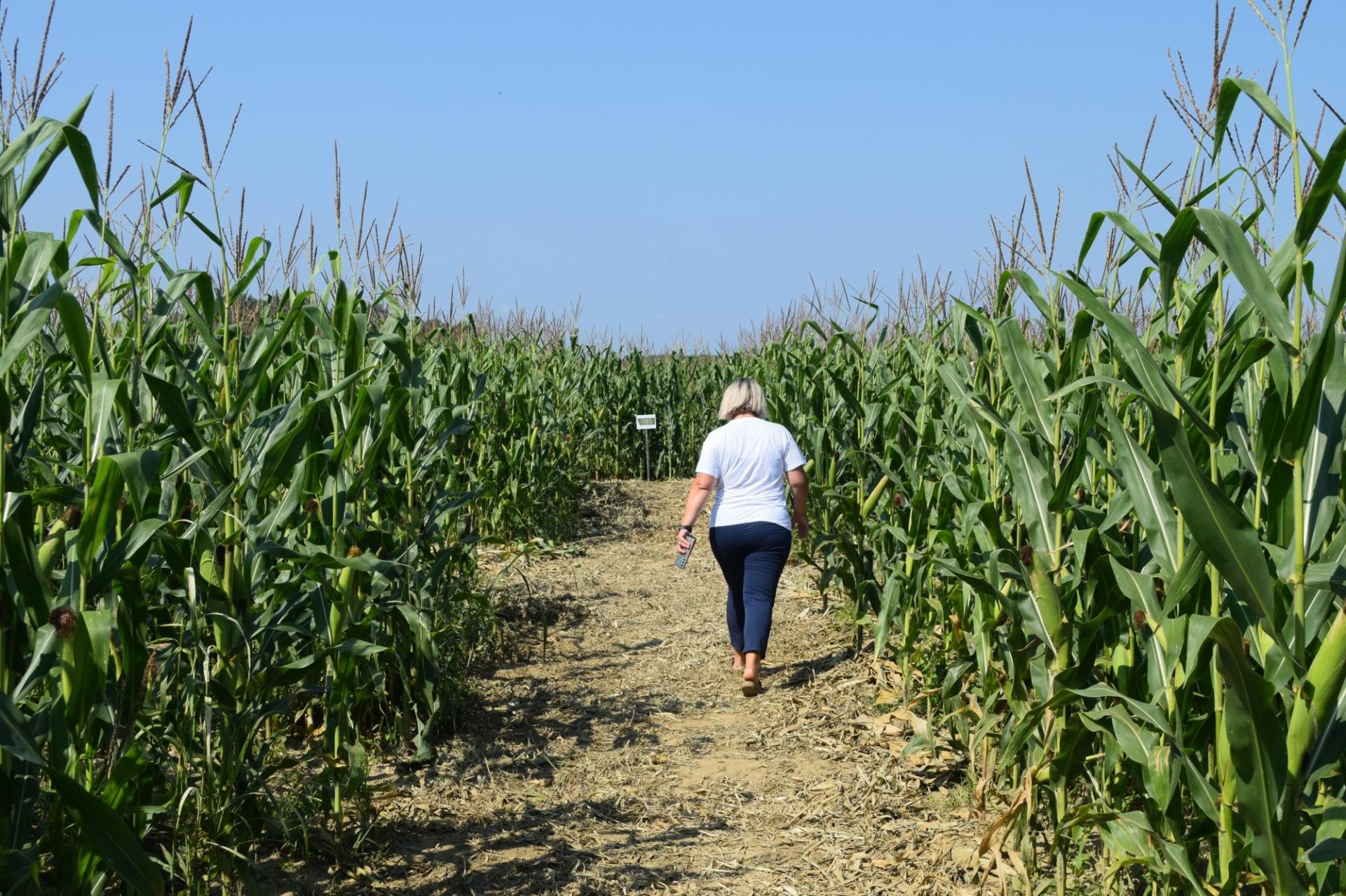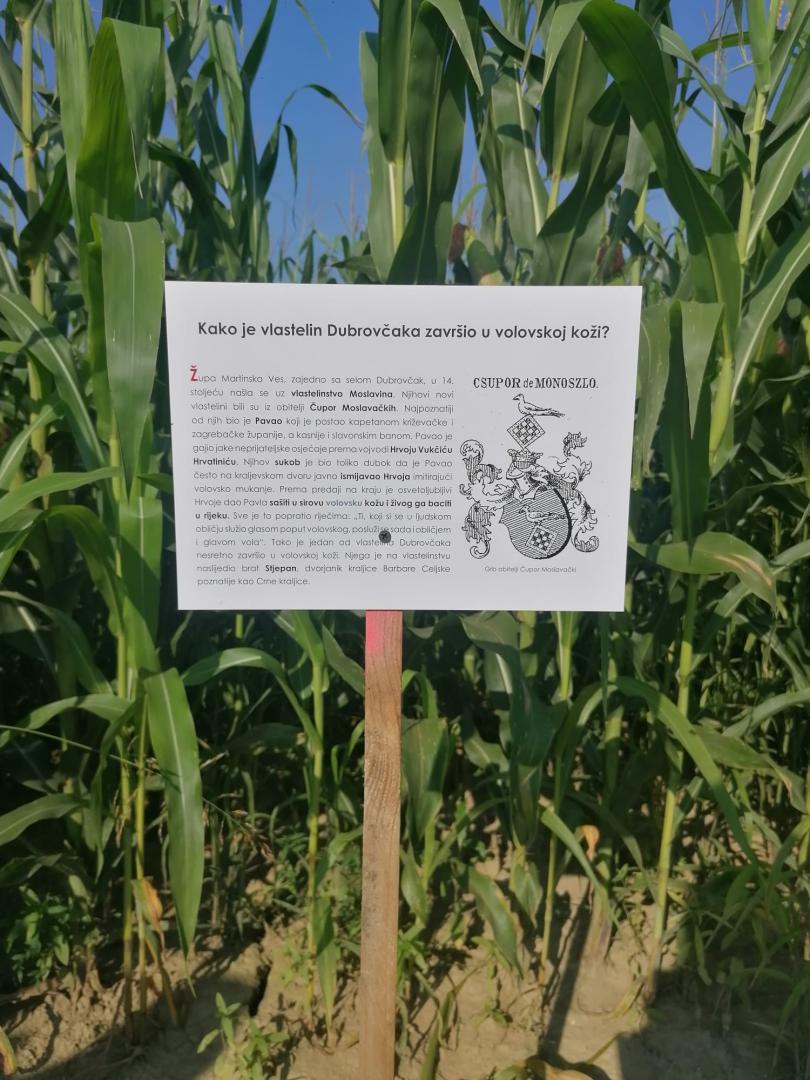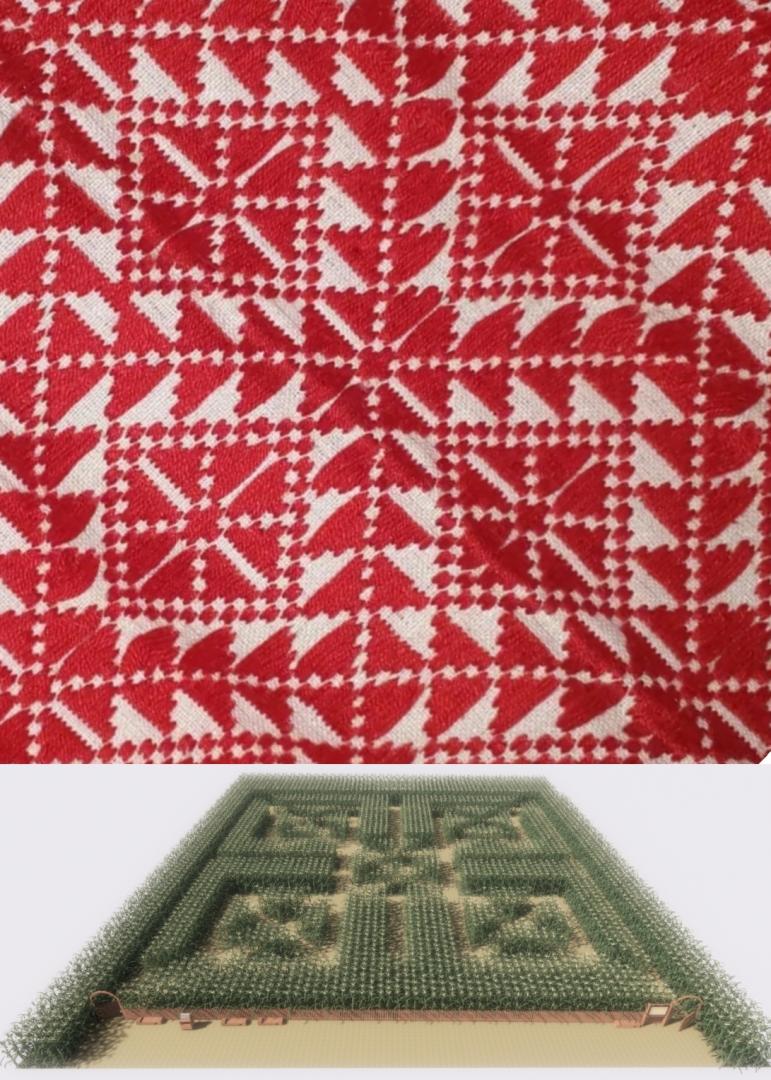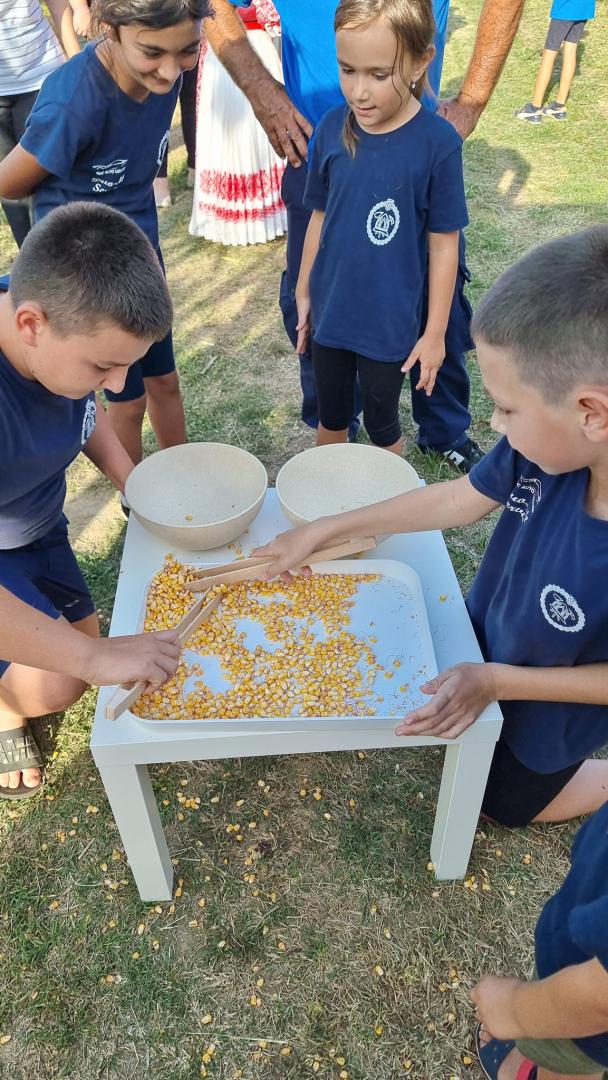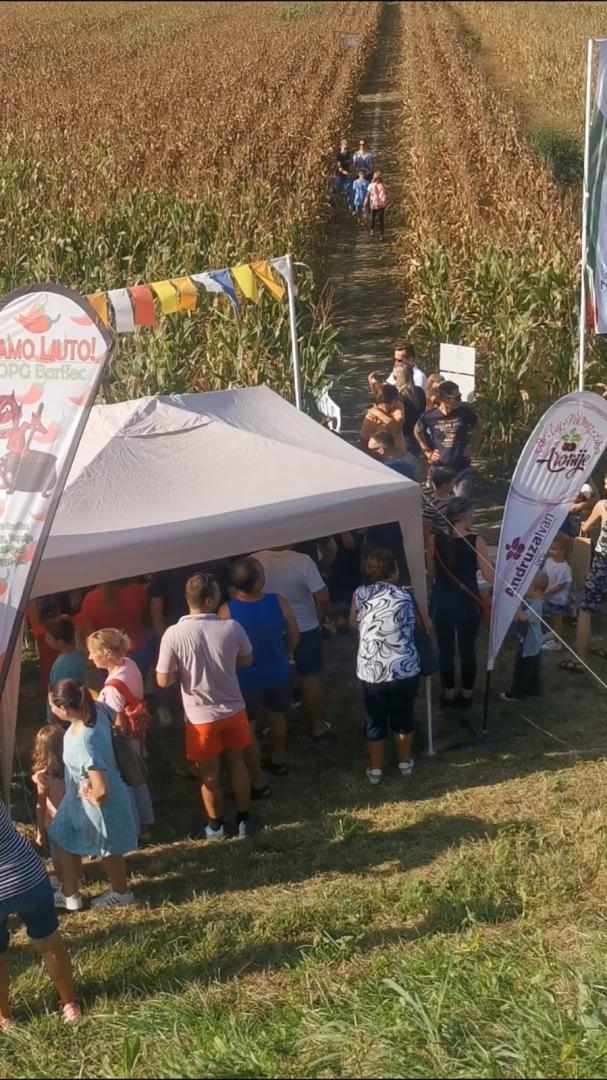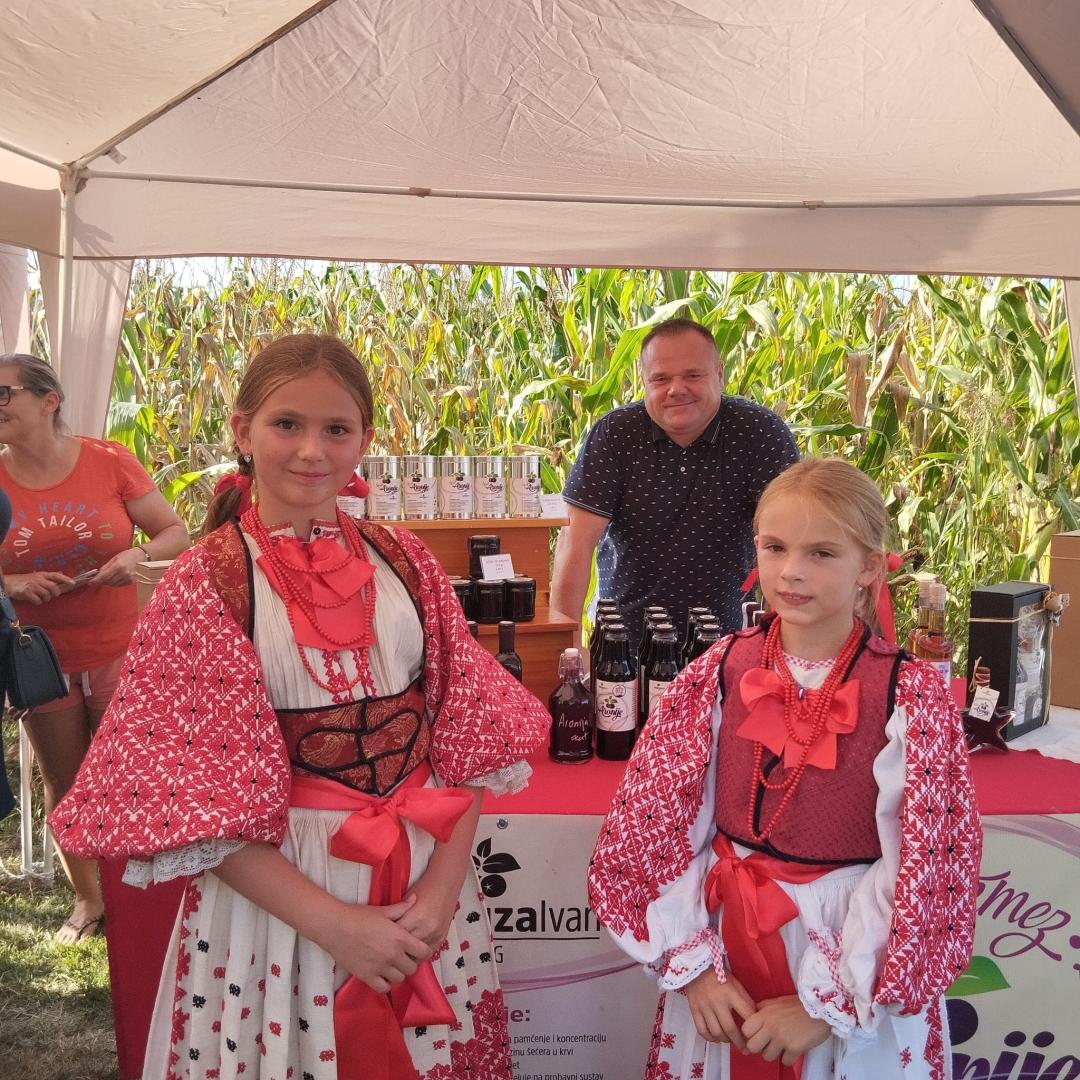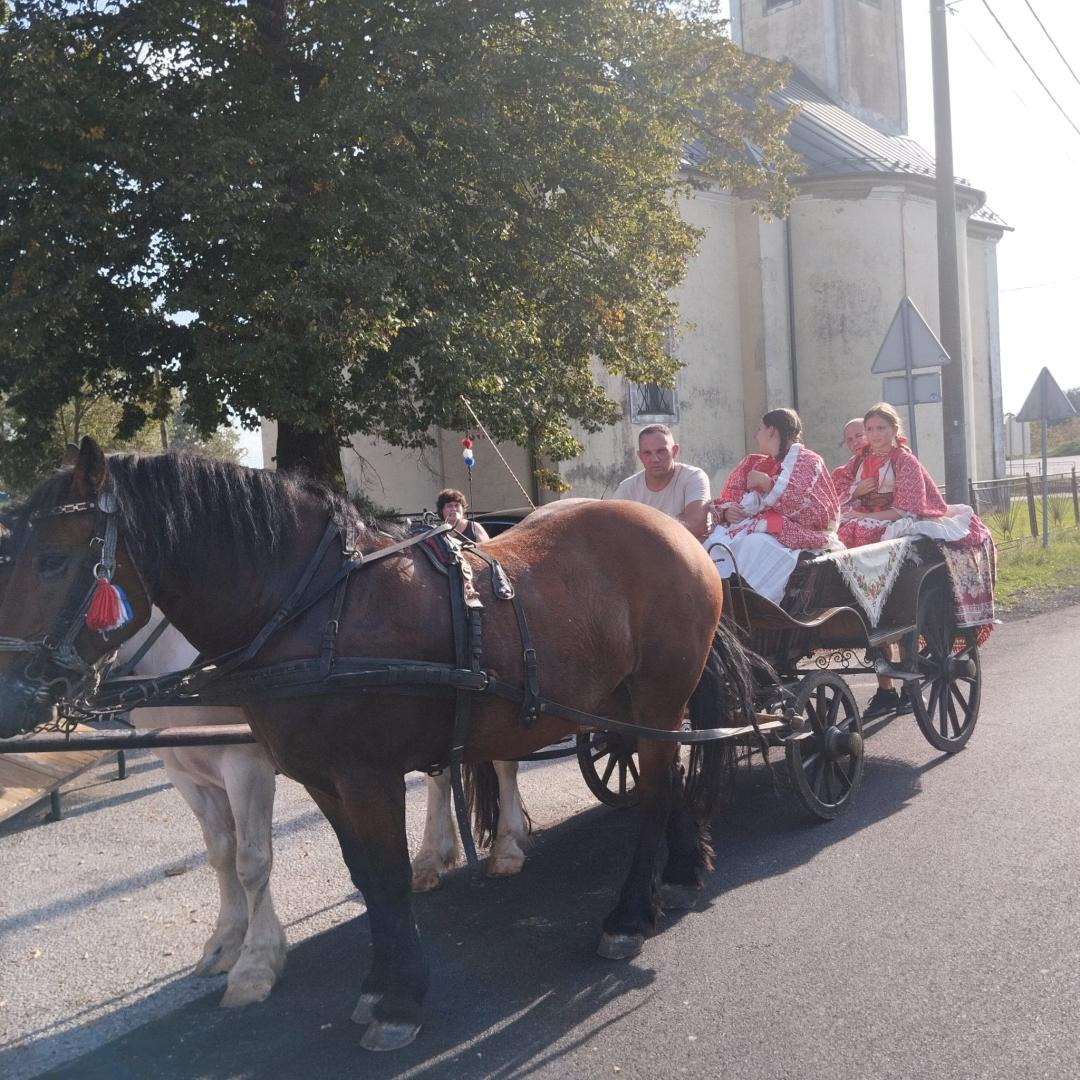Corn maze "Hrvatica"
Basic information
Project Title
Corn maze "Hrvatica"
Full project title
Corn maze in rural area of Ivanić-Grad, Croatia inspired by local folklore embroidery "Hrvatica"
Category
Regaining a sense of belonging
Project Description
In 2023 a corn maze was created in Dubrovčak Ljievi, small village near Ivanić-Grad, inspired by the motives of the local embroidery named "Hrvatica", like the corn maze in 2022, but this time three times bigger in size. Informative panels and an interactive game were installed in the maze for self-guided tours. A seasonal event "Posavina Days" was also organized in September with visitors from all over the region. The local community greatly accepted it as a sustainable way of cultural tourism.
Geographical Scope
Local
Project Region
The project is implemented at a local level, in the rural area of the city Ivanić-Grad, but the whole region gained a sense of belonging because of the motive of local folklore embroidery specific for the region of Posavina., Croatia
Urban or rural issues
Mainly rural
Physical or other transformations
It refers to other types of transformations (soft investment)
EU Programme or fund
No
Description of the project
Summary
Corn Maze "Hrvatica" (Hrvatica means "Croatian lady") was developed in Lijevi Dubrovčak in the rural area of Ivanić-Grad in 2022 and 2023 in order to valorize and promote local heritage in an innovative manner and to engage local community in cultural and outdoor tourism. The project was initiated by the local tourist board and developed in cooperation with Friends of Heritage and the local folklore society. This rural area doesn't have any museum or gallery where the local heritage could be presented, so development of a seasonal attraction of natural material was ideal for heritage interpretation and sustainable tourism. The conceptual design of the corn maze was inspired by the embroidery motive of the local folklore costume called "Hrvatica", specific to this part of Croatia. The first maze was open to the public August-October 2022 and the second one August-October 2023. In 2023 information panels and a interactive game with QR codes were created in the maze for visitors. Entrance to the maze was free of charge and average time spent in the corn maze was around 75 min; which is 30 min longer than last year. "Posavina Days" festival was organized in September and local farm producers presented their products to the public. The project had excellent national media coverage, and around 5000 visitors came to the corn maze. The local community embraced the project and was delighted to have so many visitors and groups interested in their local heritage. We believe that the project is a great example of sustainable tourism and heritage interpretation which involves local community and regains a sense of belonging. The project was recognized by the music industry, and famous Croatian cello player Stjepan Hauser, made a video in the maze for his 2024 album Hauser Classics. The project will also continue in 2024 expanding on the other rural side of the city.
Key objectives for sustainability
Corn maze 'Hrvatica' merges and emphasizes 2 out of 3 main sustainability components: environment and society. Cultural landscape is the place where the local culture has been developed and sustained it's survival continuously coexisting with the environment for centuries, as it is evident for the project area. Dubrovčak Lijevi is a rural settlement inhabited from 15th century and since then developed rich traditions and customs, which can also be seen in folk costumes, one of which has been recognized nationally - Hrvatica ("Croatian girl"). Signs of cultural development can also be found in the landscape, as it is evident in the rich corn field patterns in the landscape. By using the embroidery as a conceptual inspiration and sealing it into the landscape important for the local area, we presented and emphasized the traces of the genius loci (spirit or character of the space) which is important in shaping of present community and environment. With additional contents for the visitors we educated and renewed their knowledge about this small local area and about their rich cultural heritage. For materials we used QR codes to reduce paper waste.
Corn maze is an attraction of natural material and human intervention in nature is minimal. The attraction lasts from summer till autumn and it changes as season changes in terms of color and growth. This is an excellent learning platform for children and youth to experience changes in the nature. Since Sava river is close by, we were able to show how climate change affects our environment and extreme hot summer can affect agriculture. Every corn maze is developed on a unique rural location, adjusting to the natural background. We have also encouraged arrival to the attraction by bike, and on foot. If visitors arrived by car, we have marked specific spots where cars could be parked. During the "Posavina Days" event visitors could experience traveling to the maze with a carriage that was carried by specific Posavina horses.
Corn maze is an attraction of natural material and human intervention in nature is minimal. The attraction lasts from summer till autumn and it changes as season changes in terms of color and growth. This is an excellent learning platform for children and youth to experience changes in the nature. Since Sava river is close by, we were able to show how climate change affects our environment and extreme hot summer can affect agriculture. Every corn maze is developed on a unique rural location, adjusting to the natural background. We have also encouraged arrival to the attraction by bike, and on foot. If visitors arrived by car, we have marked specific spots where cars could be parked. During the "Posavina Days" event visitors could experience traveling to the maze with a carriage that was carried by specific Posavina horses.
Key objectives for aesthetics and quality
In terms of experience for people involved in the project management team; the project team consisted of several members; Marko Klak from the folklore society presented the whole team the local folklore heritage, and Kristina Komšo (landscape architect, NGO), made the design of the maze, while Katarina Matkerić, ethnologist and historian (NGO) was in charge of the educational part and Ana Gašparović and Laura Šejić from the Tourist Board were dealing with the coordination, promotion of the project. Locals helped with field work, cutting the corn in order to make paths. The whole project was very engaging with positive feedback from team members, locals and visitors. Folklore heritage of this part of Croatia is now surely known nationwide since the corn maze was presented on every national TV channel. Many visitors came by themselves to the corn maze and experienced self-guided tours.
The aesthetics was a very important part of the project, because the maze design was developed from a local traditional costume that has a specific embroidery motiv. The aerial footage of the corn maze describes our intentions very well: a sharp, bold, symmetrical and geometrical traditional cultural motive is woven in the linear rural landscape corn fields, both of which are in strong contrast with the organical form of the Sava river meander. Areal footage was the most important pull factor since the visual characteristics of the land art attracted the interest in people, and when we gained their attention we got a chance to tell a story about other cultural layers embedded in the whole concept.
Educational materials have been added for a better user experience. Tables with short texts and pictures presented the history and customs of the local area. In addition, visitors could try to solve a robbery case inside the corn maze inspired by a true local incident from 1915. Visitors could access this activity independently by scanning the QR code at the entrance.
The aesthetics was a very important part of the project, because the maze design was developed from a local traditional costume that has a specific embroidery motiv. The aerial footage of the corn maze describes our intentions very well: a sharp, bold, symmetrical and geometrical traditional cultural motive is woven in the linear rural landscape corn fields, both of which are in strong contrast with the organical form of the Sava river meander. Areal footage was the most important pull factor since the visual characteristics of the land art attracted the interest in people, and when we gained their attention we got a chance to tell a story about other cultural layers embedded in the whole concept.
Educational materials have been added for a better user experience. Tables with short texts and pictures presented the history and customs of the local area. In addition, visitors could try to solve a robbery case inside the corn maze inspired by a true local incident from 1915. Visitors could access this activity independently by scanning the QR code at the entrance.
Key objectives for inclusion
Corn maze was free of charge and accessible every day to visitors. It was self-guided, but groups if wanted could get a tour and educational workshops. We have had a wide range of visitors; families, couples, individuals, kindergarten and school groups, and people with disabilities, since the terrain was reachable by car, and the paths inside were stiff and wide. We also encouraged arrival by bike with guided maps to the maze and have built a small wooden bridge over the canal in the field in the first year, while in the second year the corn maze was even more accessible because it was made on a nearer corn field, next to the road and the river Sava.
Educational materials are also created with inclusion in mind. Interpretive panels were written in simple and popular language with important words and local expressions formatted in bold and italics, which facilitates readability. Each text is accompanied by an appropriate image that enables a clearer presentation of the text. The activity of solving the robbery case is also guided by the same idea. Visitors had the opportunity to choose the form of robbery they wanted to solve, given that the robbery was adapted to two generations, for children and adults. All educational materials were free of charge and available to use independently.
Also, everything was free for visitors during the "Posavina Days" event. During the event, we promoted local farms, food and drinks, animals, music, games and other cultural aspects that have their root in the Posavina region. A carriage with Croatian Posavac horses could take the visitors from the village center to the corn maze. Also, the visitor stay was prolonged in the village center visiting other tourist stakeholders.
Educational materials are also created with inclusion in mind. Interpretive panels were written in simple and popular language with important words and local expressions formatted in bold and italics, which facilitates readability. Each text is accompanied by an appropriate image that enables a clearer presentation of the text. The activity of solving the robbery case is also guided by the same idea. Visitors had the opportunity to choose the form of robbery they wanted to solve, given that the robbery was adapted to two generations, for children and adults. All educational materials were free of charge and available to use independently.
Also, everything was free for visitors during the "Posavina Days" event. During the event, we promoted local farms, food and drinks, animals, music, games and other cultural aspects that have their root in the Posavina region. A carriage with Croatian Posavac horses could take the visitors from the village center to the corn maze. Also, the visitor stay was prolonged in the village center visiting other tourist stakeholders.
Results in relation to category
The main result of this project is visible in the amount of visitors who came to this rural area from outside. Dubrovčak Lijevi settlement has 324 official inhabitants, and the maze, which was situated 2.5 kilometers from the village, attracted around 5000 visitors during the 2 months period. Most of the impressions were more than positive, and we have provided a new and fun attraction for slow and sustainable tourism. The area is well approached by bicycles because there is a national cycle route, and it also holds other natural attractions such as floodplain scenery and sandy Sava river beach, which is the biggest river in Croatia. This attraction also provided recreation and movement in the open, on the fresh air in the nature, which is specially beneficial for visiting children who could freely run around the maze. Another value that came out of the maze is the involvement of the local community of the village. Some locals were involved in the project execution as well, and their area together with the traditional folk dress "Hrvatica" became well known and talked about in the broader area and in different media nationalwise.
In addition, the project helped small community to make up a task force made out of wide range of professionals aged from 20s to 50s, who accomplished to create an unique interdisciplinary project with exchange of different insights, knowledge and ideas and achieved great intergenerational cooperation.
This successful project helped to inspire different old and new stakeholders to continue with the project in this year too, but with additional contents related to the local cultural, historical and natural heritage, as this project showed that the inherited and smaller site specific values can be implemented into new and contemporary interpretation. We are happy to mention that the project received an annual award "Rose of Zagreb County" from the regional tourist board for this innovative and sustainable tourism product.
In addition, the project helped small community to make up a task force made out of wide range of professionals aged from 20s to 50s, who accomplished to create an unique interdisciplinary project with exchange of different insights, knowledge and ideas and achieved great intergenerational cooperation.
This successful project helped to inspire different old and new stakeholders to continue with the project in this year too, but with additional contents related to the local cultural, historical and natural heritage, as this project showed that the inherited and smaller site specific values can be implemented into new and contemporary interpretation. We are happy to mention that the project received an annual award "Rose of Zagreb County" from the regional tourist board for this innovative and sustainable tourism product.
How Citizens benefit
Two civil society organizations were largely involved in the project development - NGO Friends of Heritage and KUD Posavec folklore society with expertise and field work. Citizens living in this rural area also got an opportunity to build the maze with the organisers and later to reconnect with their local traditions and heritage and explore their surrounding in an innovative way. Additionally, the corn maze was highly recognized by broad range of national media which helped to promote the cultural and natural heritage of the local region of a small rural settlement of Dubrovčak Lijevi to a wide public. During the project a local farm fair as a part of the "Posavina Days" was organised in order to showcase their local crafts, local cuisine and folklore dancing workshops. After the project completion they expressed a desire for continuation of the project in 2024 and their intention to be involved as a part of the project during the corn maze season.
Physical or other transformations
It refers to other types of transformations (soft investment)
Innovative character
Corn mazes are generally common and known to be fun places like "Hrvatica" was, but they are also known for being designed in a "random" labyrinth or popular shape pattern, not related to the local genius loci (spirit of the place), which makes our approach different and innovative. While making intervention in the open space, we thought about adding extra value to the rural landscape itself by using local identity as a major symbol and attraction to the maze. In our case, this was introduced in the form of geometrical and symmetrical pattern inspired by the material heritage of the embroidery of the related local folk costume "Hrvatica" ("Croatian girl"), which is also important on the national level. The pattern itself is adjusted to the size of the site and considering the minimal standards for the safety of the pathways.
Another major innovation is that the goal of the maze was not to find the exit; the design actually enabled the opposite - to find the exit immediately, since the maze does not have one main path. The main goal was to find all the scattered panels that showcase local history, customs and regional characteristics through stories such as How Sava named Dubrovčak Lijevi, How did Marija Jurić Zagorka create Hrvatica, Tips from Posavci for a rich corn harvest, How did the nobleman of Dubrovčak end up in an ox skin?, or How did the famous hajduk hide in Dubrovčak? For those with an adventurous spirit, the goal was to solve a robbery case based on a true local event. The visitors were looking for clues hidden in the corn maze so that they could claim the final reward. The purpose of this corn maze is for visitors to completely immerse themselves in it and use that opportunity to get to know the local heritage in an new and interactive way.
Also, a new innovation of the project was "Posavina Days" event, that gathered the local community, tourist stakeholders, local farmers and visitors from around the region.
Another major innovation is that the goal of the maze was not to find the exit; the design actually enabled the opposite - to find the exit immediately, since the maze does not have one main path. The main goal was to find all the scattered panels that showcase local history, customs and regional characteristics through stories such as How Sava named Dubrovčak Lijevi, How did Marija Jurić Zagorka create Hrvatica, Tips from Posavci for a rich corn harvest, How did the nobleman of Dubrovčak end up in an ox skin?, or How did the famous hajduk hide in Dubrovčak? For those with an adventurous spirit, the goal was to solve a robbery case based on a true local event. The visitors were looking for clues hidden in the corn maze so that they could claim the final reward. The purpose of this corn maze is for visitors to completely immerse themselves in it and use that opportunity to get to know the local heritage in an new and interactive way.
Also, a new innovation of the project was "Posavina Days" event, that gathered the local community, tourist stakeholders, local farmers and visitors from around the region.
Disciplines/knowledge reflected
During development and implementation of the project we have cooperated with people with different expertise: landscape architect, local farmers and local community, surveyor (geodesy), museologist, ethnologist, historian, travel product developer, PR and marketing. Corn in the corn field was a produce of the Croatian agriculture institute (www.poljinos.hr) so it was an additional value to promote the local crop from the local production and not an imported crop from the large agriculture corporation.
Initially, it was the cooperation between ethnologist, landscape architect and surveyor. The conceptual idea was made by landscape architect, which was inspired by the data from the local ethnologist. The concept was developed into the precise implementation plan with the help of the local surveyor and brought to reality with the help of the locals from the KUD Posavec folklore society and Friends of Heritage members. After we developed the maze paths, museologists, ethnologists, historians and travel product developer cooperated on the visual identity, educational assignments, communication, promotion and visitor experience. We had also an archaeologist on the field creating our aerial photographs.
Initially, it was the cooperation between ethnologist, landscape architect and surveyor. The conceptual idea was made by landscape architect, which was inspired by the data from the local ethnologist. The concept was developed into the precise implementation plan with the help of the local surveyor and brought to reality with the help of the locals from the KUD Posavec folklore society and Friends of Heritage members. After we developed the maze paths, museologists, ethnologists, historians and travel product developer cooperated on the visual identity, educational assignments, communication, promotion and visitor experience. We had also an archaeologist on the field creating our aerial photographs.
Methodology used
We recognized the need for promoting the rural area in the outskirts of the city, with the aim of dispersing cultural and recreational tourism away from the center and bringing the attention to the more distanced areas. Most of the activities were previously organized around city center (festivals, intepretation panels), or forests (educational trails), and with this project we wanted to create a better connection between rural-urban community and create a platform for future sustainable tourism products in the rural area.
The main professional methodology used by the landcape architect was analytics of the project area which gave insight about what is the main genius loci which we can use in this maze, as a tool to enhance other spatial features which are not necessarily visible or known: what helped to shape the identity of this area, what is something that is related to the culture and the inhabitants today, what can we recognize and use as a powerful symbol of the space we are working in, etc. This process was held with the help of a local ethnologist, who provided cultural facts about the area. Gathered conclusions were transformed in the conceptual sketches and final plans, after which the professional surveyist came to help with the field work. By using the total station tool with GPS features, he was able to precisely determine the terrain points and the work team, with the help of local fire department members, cut out the pathways in the corn field.
The final stage in visitor experience development involved creating educational activities, setting of intepretation and question panels in the maze, and access points from the main road. We could make visitor anaylitcs due to the QR scans. We have then started marketing and promotion acitivities across several media channels - TV (national, regional), radio and online. We have sent invitation letters to travel agencies and schools.
The main professional methodology used by the landcape architect was analytics of the project area which gave insight about what is the main genius loci which we can use in this maze, as a tool to enhance other spatial features which are not necessarily visible or known: what helped to shape the identity of this area, what is something that is related to the culture and the inhabitants today, what can we recognize and use as a powerful symbol of the space we are working in, etc. This process was held with the help of a local ethnologist, who provided cultural facts about the area. Gathered conclusions were transformed in the conceptual sketches and final plans, after which the professional surveyist came to help with the field work. By using the total station tool with GPS features, he was able to precisely determine the terrain points and the work team, with the help of local fire department members, cut out the pathways in the corn field.
The final stage in visitor experience development involved creating educational activities, setting of intepretation and question panels in the maze, and access points from the main road. We could make visitor anaylitcs due to the QR scans. We have then started marketing and promotion acitivities across several media channels - TV (national, regional), radio and online. We have sent invitation letters to travel agencies and schools.
How stakeholders are engaged
Our project was given financial and promotional support by the Agricultural Institute in Osijek and local stakeholders (The City of Ivanić-Grad, Tourist Board of Ivanić-Grad, Zagreb County Tourist Board and Zagreb County). In February 2023 we received a prize for best sustainable tourism project by the Zagreb County Tourist board for our corn maze project from 2022. Professional and educational support was given by civil organizations Friends of Heritage, KUD Posavec folklore society and Museum of Ivanić-Grad. Broad media coverage during the project was from the local, regional and national level (Croatian Radiotelevision, RTL, Nova TV, local Family Radio Ivanić, wide range of news portals and social media pages). In October 2023 we have applied for the support on the regional level for the project continuation in 2024 with additional land art features, and we also tend to promote the corn maze in the Croatia Airlines magazine.
Global challenges
This project helps to recognize the importance of smaller local areas and dispersion of tourist attraction in the broader areas away from already known places and cities. It helps to inspire and remind the local community of their strengths, values and natural and cultural attractions they have around and which they can use as a tool to develop the area in innovative ways. It can help to strengthen the community and make them gather around similar topics and being involved in the decision-making process and creative ideas, which can provide them recognition and promotion. Rural and recreational tourism in smaller scale can help to improve the smaller community economy, if focused on strong stories and motives which can provide an unique experience possible only in the specific area. This type of tourism also promotes physical and cognitive wellbeing, spending time in the open air and in the natural surrounding, moving and using your skills to participate in an educational and playful activities.
Learning transferred to other parties
Every part of this project could be implemented into any other rural area, the same methodology could be used in every other open space. The field does not necessarily have to be made out of corn, it could include different types of plants or materials (e.g. wheat or sunflower fields in the Slavonic region or stone in the Dalmatian region) for the land art inspired by different local stories and heritage aspects. Every space has its inherent value, core sense and character of place which could very easily be interpreted in different natural temporary land art installation, together with different kinds of educational and fun activities such as solving a robbery case we implemented.
Keywords
involving local community
sustainable tourism
cultural landscape promotion
innovative heritage interpretation
multisector cooperation

